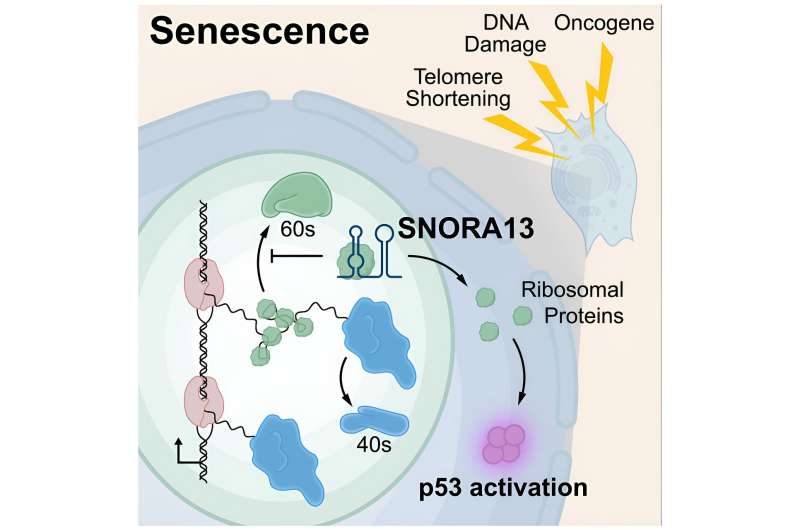Study identifies RNA molecule that regulates cellular aging


Credit: Cell (2024). DOI: 10.1016/j.cell.2024.06.019
A team led by researchers at UT Southwestern Medical Center has discovered a new way cells regulate senescence, an irreversible end to cell division. The findings, published in Cellcould one day lead to new interventions for a variety of diseases associated with aging, including neurodegenerative and cardiovascular diseases, diabetes and cancer, as well as new therapies for a group of diseases known as ribosomopathies.
“There is great interest in reducing senescence to slow or reverse aging or diseases associated with aging. We have discovered a noncoding RNA that, when inhibited, strongly impairs senescence, suggesting that it could be a therapeutic target for diseases associated with aging,” said Joshua Mendell, MD, PhD, professor of molecular biology and member of the Harold C. Simmons Comprehensive Cancer Center at UT Southwestern. He is also a Howard Hughes Medical Institute Investigator.
Dr. Mendell led the study with co-first authors Yujing Cheng, Ph.D., a recent graduate of the Genetics, Development and Disease graduate program; and Siwen Wang, MD, a former postdoctoral researcher, both in the Mendell lab.
Cellular senescence is a “double-edged sword,” Dr. Mendell explains. Cells sometimes senesce when a cancer-causing mutation occurs, which stops uncontrolled cell division and prevents tumors from growing. On the other hand, too much senescence contributes to aging and degenerative diseases.
The Mendell lab has long studied noncoding RNAs and discovered new roles for these molecules in both health and disease. In this new study, he and his colleagues used a gene-regulating technique called CRISPR interference to individually inactivate thousands of noncoding RNAs in human cells that carried a cancer-causing mutation. Typically, this mutation prompts cells to become senescent; however, inactivating a noncoding RNA involved in senescence caused the cells to continue dividing.
These experiments soon revealed the existence of a previously unknown regulator of senescence called SNORA13, a member of a family of noncoding RNAs known as small nucleolar RNAs, which are thought to serve primarily as guides for the chemical modification of other RNA molecules. A series of additional experiments showed that SNORA13 plays another important and unexpected role: slowing the construction of ribosomes, the cellular machines that synthesize proteins.
Dr. Mendell explained that cellular stress, such as a cancer-causing mutation, can disrupt ribosome assembly and push cells toward senescence. However, deleting SNORA13 caused ribosome assembly to speed up, blocking the quality control that would normally trigger senescence and allowing cells to continue dividing.
Learning more about this process could eventually help researchers control it, Dr. Mendell said. For example, developing drugs that push cells toward senescence could offer a new way to treat cancer. Conversely, developing drugs that prevent senescence could slow aging and the diseases that typically accompany it, such as cardiovascular disease, neurodegenerative diseases and diabetes.
Moreover, because of SNORA13’s essential function in regulating ribosome assembly, targeting this non-coding RNA could one day be used to treat ribosomopathies, diseases characterized by abnormal ribosome production or function, such as Treacher Collins syndrome or Diamond-Blackfan anemia.
More information:
Yujing Cheng et al, A non-canonical role for a small nucleolar RNA in ribosome biogenesis and senescence, Cell (2024). DOI: 10.1016/j.cell.2024.06.019
Journal information:
Cell
Provided by UT Southwestern Medical Center
Quote:Study identifies RNA molecule that regulates cellular aging (July 17, 2024) retrieved July 18, 2024 from https://phys.org/news/2024-07-rna-molecule-cellular-aging.html
This document is subject to copyright. Apart from any fair dealing for the purpose of private study or research, no part may be reproduced without written permission. The content is provided for informational purposes only.
News Source : phys.org
Gn Health





